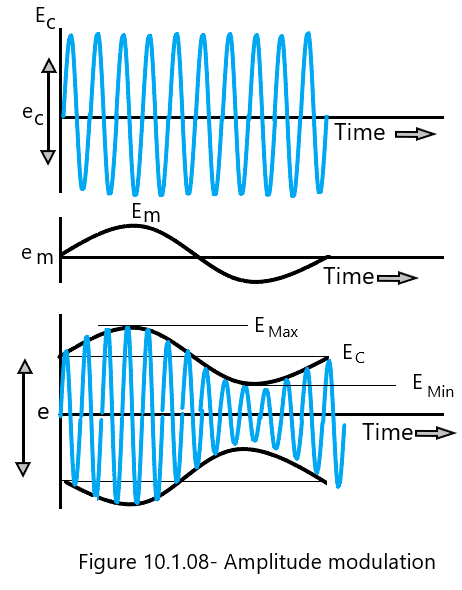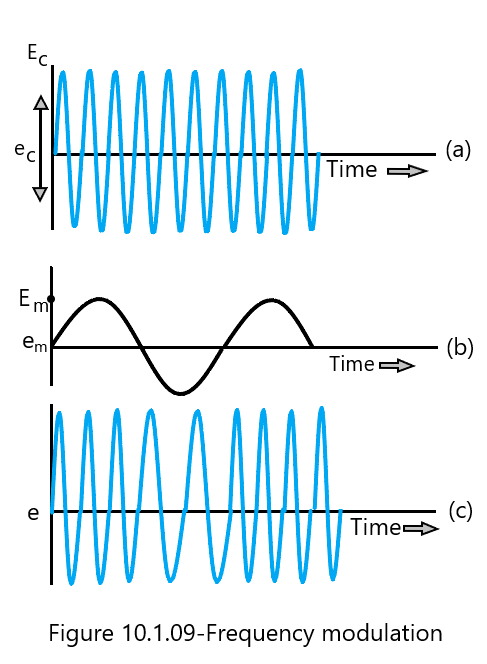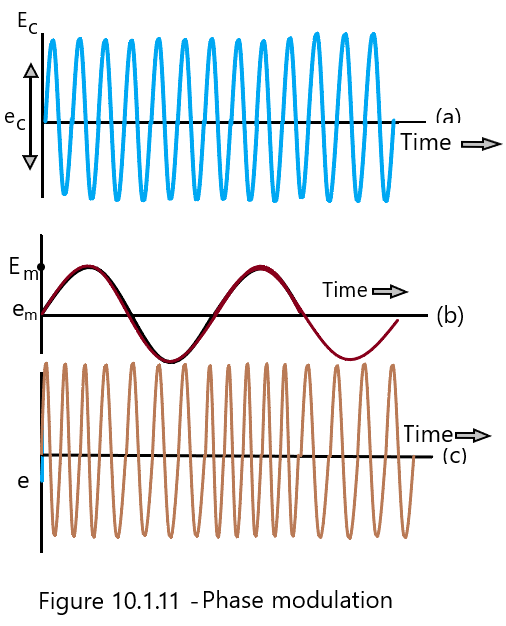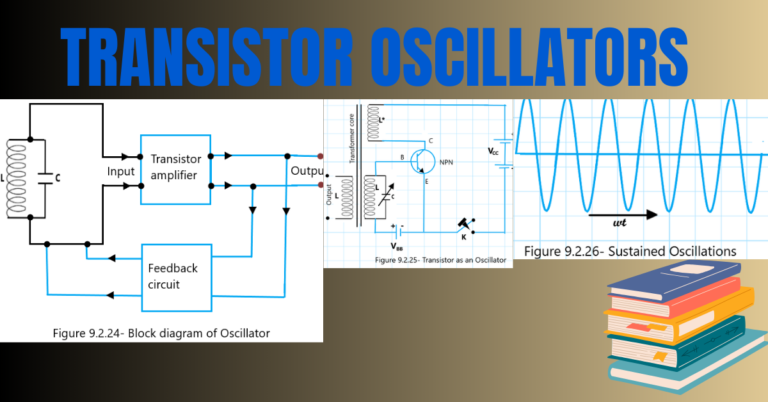Modulation
Introduction:
Definition of Modulation:
Modulation is a fundamental process in signal processing and communication systems. It involves the modification of a carrier signal’s amplitude, frequency, or phase in response to variations in a message signal. This technique allows information to be transmitted over long distances, overcoming challenges such as signal attenuation and interference.
In modulation, the carrier signal serves as the carrier wave that is modulated due to the information-bearing signal, also known as the message signal. By superimposing the message signal onto the carrier signal, the resulting modulated signal carries the information in a form that is suitable for efficient transmission and reception.
Importance and Applications:
1. Enhanced Signal Integrity: Modulation is crucial in enhancing signal integrity, especially in long-distance communication. By modulating the carrier signal, the information can be transmitted efficiently without significant degradation.
2. Bandwidth Efficiency: Modulation techniques enable the optimization of bandwidth usage. By adjusting the characteristics of the carrier signal, more information can be transmitted within the available bandwidth, making efficient use of the communication channel.
3. Immunity to Interference: Modulation helps make signals more robust against various types of interference, including noise and other signals in the environment. This is particularly vital in wireless communication systems.
4. Versatility in Communication Systems: Modulation is a versatile tool used in a wide array of communication systems. It forms the backbone of technologies like radio broadcasting, television transmission, satellite communication, and cellular networks.
5. Data Transmission in Digital Communication: In digital communication, modulation is crucial for converting digital data into analog signals that can be easily transmitted over analog channels. Techniques like Amplitude Shift Keying (ASK), Frequency Shift Keying (FSK), and Phase Shift Keying (PSK) are commonly used.
6. Music and Audio Processing: In music, modulation refers to a change in key, which can greatly influence the emotional and tonal character of a piece. It plays a central role in creating tension, contrast, and interest in musical compositions.
7. Radar and Sonar Systems: Modulation is pivotal in radar and sonar systems used for navigation, object detection, and ranging. It allows for the precise measurement of distances and speeds by manipulating electromagnetic or acoustic waves.
8. Medical Imaging and Remote Sensing: In fields like medical imaging and remote sensing, modulation techniques are employed to extract information from received signals. This aids in tasks such as imaging, object detection, and terrain mapping.
Basic Concepts of Modulation:
Carrier Signal, Message Signal, and Modulated Signal
Modulation, at its core, revolves around three fundamental components: the carrier signal, the message signal, and the resulting modulated signal. Understanding these elements is crucial to comprehending how information is transmitted effectively through various communication systems.
1. Carrier Signal:
The carrier signal forms the foundation of any modulated communication. It is a high-frequency waveform that acts as a vehicle for carrying information. This signal, characterized by its constant frequency and amplitude, serves as the ‘envelope’ for the message signal. In essence, it provides the medium through which the message signal can be transmitted over long distances.
2. Message Signal:
The message signal, also known as the baseband signal, contains the actual information that needs to be transmitted. It represents the data or content that is modulated onto the carrier signal. This signal typically has a much lower frequency compared to the carrier signal. It can be analog, carrying continuous information, or digital, consisting of discrete values. The message signal is the essence of the communication, carrying meaningful content.
3. Modulated Signal:
The modulated signal is the result of combining the carrier signal and the message signal. Through modulation, the characteristics of the carrier signal are altered in accordance with the variations in the message signal. This creates a new signal, which is a composite of both the carrier and message signals. The modulated signal is what gets transmitted through the communication channel. It encapsulates the information from the message signal in a form that is suitable for efficient transmission and reception.
In practice, the modulated signal is what is transmitted over long distances, overcoming challenges like signal degradation, interference, and noise. Upon reception, the original message signal can be retrieved through a process called demodulation, which essentially reverses the modulation process.
Understanding these basic concepts is pivotal to grasping the essence of modulation and its significance in various communication systems. It forms the basis for more advanced modulation techniques and their applications across diverse fields, including telecommunications, broadcasting, music, and many others.
Types of Modulation:
1. Amplitude Modulation (AM):
It is one of the earliest and most straightforward forms of modulation. In AM, the amplitude of the carrier signal is varied in proportion to the amplitude of the message signal. This means that as the message signal fluctuates, it causes corresponding changes in the amplitude of the carrier wave. These variations carry information.
AM finds extensive application in broadcasting, particularly in the transmission of voice signals over AM radio frequencies. It’s relatively simple to implement and has the advantage of being able to carry both audio and video signals. However, AM signals are susceptible to noise and interference, which can affect signal quality.
AM is a modulation technique used in electronic communication, particularly in broadcasting audio signals. It involves varying the amplitude of a high-frequency carrier signal in proportion to the instantaneous amplitude of a modulating signal or message signal.
Explanation:
In AM, the carrier signal (a high-frequency wave) remains constant in frequency and phase. However, its amplitude is altered in correspondence with the amplitude of the message signal. When graphed, the resulting waveform displays variations in the height (amplitude) of the carrier wave. These variations mirror the changes in the message signal.

Advantages and Disadvantages of AM
Advantages:
- Simplicity of Implementation: AM transmitters and receivers are relatively simple to design and construct compared to other modulation techniques.
- Efficient Use of Bandwidth: AM requires less bandwidth compared to FM or PM, making it suitable for certain applications.
- Compatibility with Existing Receivers: AM signals can be received using simple, widely available radio receivers.
Disadvantages:
- Susceptibility to Noise and Interference: AM signals are prone to atmospheric noise, electrical interference, and man-made obstructions, which can degrade signal quality.
- Limited Signal Fidelity: AM has a narrower frequency range compared to FM, which can result in reduced audio quality.
- Inefficiency in Power Usage: AM transmitters often require higher power levels to achieve the same signal quality as FM or PM.
AM in Communication Systems: AM has found enduring utility in various communication systems:
- AM Radio Broadcasting: AM has been a primary method for transmitting radio broadcasts, especially for talk shows and news programs.
- Aviation Communications: AM was historically used in aircraft communications due to its simplicity, but it has largely been replaced with more advanced modulation techniques in modern aviation.
- Two-Way Radio Communication: AM is still used in specific applications like citizen band (CB) radio and marine communication.
- While AM has been surpassed with more advanced modulation techniques in many areas, its historical significance and continued use in certain applications highlight its enduring relevance in the world of communication.
2. Frequency Modulation (FM):
FM takes a different approach by varying the frequency of the carrier signal in accordance with the message signal. As the amplitude of the message signal changes, the frequency of the carrier signal changes proportionally. FM is known for its superior resistance to noise and interference compared to AM.
FM is widely used in high-fidelity audio broadcasting and is the standard for FM radio transmissions. It is also employed in applications where signal quality is of paramount importance, such as music broadcasting and two-way radio communication systems.
Explanation and Diagram:
FM is a method used in electronic communication, especially in radio transmission, to encode information on a carrier wave by varying the frequency. Unlike AM, which varies the amplitude of the carrier wave, FM changes the frequency of the wave in proportion to the waveform being transmitted. This means that in FM, the signal is encoded by changing the rate at which the carrier wave oscillates.

In the diagram, you can see the carrier wave in blue. As the information signal (in black) varies, the frequency of the carrier wave changes correspondingly. This modulation process allows for the transmission of audio signals, data, and other types of information over long distances.
Advantages and disadvantages:
Advantages:
- Improved Signal-to-Noise Ratio (SNR): FM provides better resistance to noise and interference compared to AM. This is because changes in amplitude due to noise do not affect the received signal.
- Higher Fidelity Audio: FM transmission produces higher quality audio as it maintains a constant amplitude, resulting in less distortion.
- Greater Bandwidth Efficiency: FM allows for the transmission of a wider range of frequencies within a given bandwidth, making it suitable for high-fidelity audio and high-quality data transmission.
- Reduced Interference: FM signals are less susceptible to interference from other electronic devices and power lines, making them a preferred choice in areas with high electromagnetic interference.
- Improved Signal Coverage: FM signals have a more consistent coverage area due to the constant amplitude, which reduces the variability of signal strength.
Disadvantages:
- Bandwidth Requirements: FM requires a wider bandwidth compared to AM for transmission, which means it occupies more space on the radio spectrum.
- Complexity of Receivers: FM receivers are more complex compared to AM receivers, which can make them more expensive to produce.
- Limited Range: FM signals have a shorter effective range compared to AM signals, especially in urban environments with many obstructions.
- Inefficiency in Power Usage: FM transmitters tend to use more power compared to AM transmitters, which can be a consideration for portable or battery-powered devices.
- Susceptibility to Multi-Path Fading: FM signals can suffer from multi-path fading, where signals arriving at a receiver by different paths interfere destructively, causing fluctuations in received signal strength.
FM in Communication Systems:
FM is widely used in various communication systems.
- Broadcasting: FM is extensively used in radio broadcasting for its high-quality audio transmission capabilities.
- Wireless Communication: FM is utilized in many wireless communication systems, including two-way radios, walkie-talkies, and some mobile phone systems.
- Radar Systems: FM is employed in radar applications, where it is used for pulse compression to improve range resolution.
- Television: In some cases, FM is used for transmitting the audio signal in television broadcasts, especially in countries using the NTSC system.
- Satellite Communication: FM modulation is used in satellite communication to transmit signals over long distances with minimal interference.
- Overall, FM modulation plays a crucial role in modern communication systems, providing a reliable and high-quality method for transmitting various forms of information.
3. Phase Modulation (PM):
PM is a modulation technique where the phase of the carrier signal is altered in response to changes in the message signal. Specifically, the angle or position of the carrier wave is shifted in relation to its regular cycle. This variation encodes the information.
PM is a critical component in more complex modulation schemes and is used in various digital communication systems, including satellite communication and wireless networks. It’s valued for its spectral efficiency and its ability to transmit information reliably over long distances.
Each of these modulation techniques possesses unique characteristics and applications, making them suitable for specific communication scenarios. The choice of modulation type depends on factors like the nature of the message signal, the desired signal quality, and the presence of potential sources of interference.
Explanation and Diagram:
PM is a modulation technique widely used in various forms of communication systems. Unlike AM, which encodes information in the amplitude of a carrier wave, PM encodes information by varying the phase of the carrier wave.
In PM, the instantaneous phase of the carrier wave is altered in proportion to the instantaneous amplitude of the message signal. This means that changes in the message signal lead to corresponding changes in the phase of the carrier wave.

In the diagram above, you can see the carrier wave (in blue) and the message signal (in red). As the amplitude of the message signal changes, the phase of the carrier wave shifts accordingly. This modulation process enables the transmission of information.
Advantages and disadvantages:
Advantages:
- High Efficiency in Bandwidth Utilization: Phase modulation is highly bandwidth-efficient. It allows for a greater amount of information to be transmitted within a given bandwidth compared to some other modulation techniques.
- Resistance to Amplitude Variations: PM is less affected by changes in signal amplitude, which makes it more robust in environments where amplitude variations are common.
- Well-suited for Digital Data Transmission: PM forms the basis for more complex digital modulation schemes, such as Quadrature Amplitude Modulation (QAM), which are widely used in digital communication systems.
- Improved Signal-to-Noise Ratio (SNR): PM can provide a higher signal-to-noise ratio compared to amplitude modulation, resulting in clearer reception.
- Phase Coherent Demodulation: PM allows for phase-coherent demodulation, which is important in applications like radar and coherent communication systems.
Disadvantages:
- Complex Receivers: PM receivers can be more complex and costly to design and implement compared to receivers for simpler modulation techniques.
- Susceptibility to Phase Noise: PM signals can be sensitive to phase noise introduced using various components in the communication system, which can degrade signal quality.
- Not as Common in Analog Audio Broadcasting: While frequency modulation (FM) is the standard for analog audio broadcasting, PM is less commonly used for this purpose.
- Less Tolerant to Nonlinearities: PM signals can be more susceptible to distortions caused by nonlinearity in amplifiers and other components of the communication system.
PM in Communication Systems:
PM is integral to various communication systems.
- Digital Communication: PM forms the foundation for more complex digital modulation schemes like Quadrature Phase Shift Keying (QPSK) and Quadrature Amplitude Modulation (QAM) used in technologies like Wi-Fi, Bluetooth, and cellular communication.
- Radar Systems: PM is extensively employed in radar systems for its ability to provide accurate range and velocity information.
- Satellite Communication: PM is used in satellite communication systems due to its efficiency in utilizing available bandwidth and resistance to noise.
- Optical Communication: In optical fiber communication, PM is used to encode information on light waves for high-speed data transmission.
- Navigation Systems: PM is used in global navigation satellite systems (GNSS) like GPS for precise positioning and timing information.
In conclusion, PM is a fundamental modulation technique with a wide range of applications in modern communication systems. Its efficiency in bandwidth utilization, resistance to amplitude variations, and suitability for digital data transmission make it an indispensable tool in the field of telecommunications. Understanding PM is essential for engineers and technicians working in the design and optimization of communication systems.
Modulation Index and Deviation: Understanding the Essence of Modulation
Modulation index and deviation are fundamental concepts in the world of signal processing and communication engineering. They play a pivotal role in shaping how information is transmitted over various mediums. Let’s delve into what these terms mean and why they are crucial in the realm of modulation.
Definition and importance:
Modulation Index:
The modulation index, often denoted by ‘β’, is a dimensionless quantity that characterizes the extent of modulation in a signal. In essence, it quantifies the ratio of the peak amplitude of the modulating signal to the peak amplitude of the carrier signal.
Mathematically, it is expressed as:
β=Amod /Acarrier
Where:
A mod is the peak amplitude of the modulating signal.
A carrier is the peak amplitude of the carrier signal.
A high modulation index indicates a strong modulation, while a low index suggests a weaker one. This parameter is crucial in determining the bandwidth of the modulated signal and subsequently impacts the efficiency of spectrum utilization.
Deviation
Deviation, denoted as’Δf’, pertains specifically to FM. It signifies the maximum extent to which the instantaneous frequency of the carrier signal deviates from its unmodulated state.
Δf = fmax−fmin
Where:
fmax is the maximum frequency of the modulated signal.
fmin is the minimum frequency of the modulated signal.
Relationship with Signal Quality:
The modulation index and deviation are intrinsically linked to the quality of the transmitted signal.
In FM systems:
In FM systems, deviation directly influences the signal-to-noise ratio (SNR) and the signal’s immunity to noise and interference. A higher deviation allows for a greater tolerance to noise, leading to a clearer and more robust reception.
Moreover, deviation has a direct impact on the bandwidth requirements. A larger deviation necessitates a wider bandwidth, which means that FM signals with a higher deviation occupy more space on the frequency spectrum.
In AM systems:
In AM systems, the modulation index affects the extent of variation in the carrier wave’s amplitude. This, in turn, determines the power distribution in the spectrum. A higher modulation index results in a more bandwidth-intensive signal, but it also leads to richer information content.
Conclusion:
Understanding the modulation index and deviation is pivotal in designing efficient and reliable communication systems. These parameters govern the quality, efficiency, and bandwidth utilization of modulated signals. Striking the right balance between modulation index and deviation is a key aspect of optimizing communication systems for various applications. Whether it’s broadcasting, wireless communication, or any other form of signal transmission, a thorough grasp of these concepts is essential for engineers and technicians alike.
Applications of Modulation
1. Radio Broadcasting:
Radio broadcasting is one of its oldest and most widespread applications. It revolutionized mass communication by allowing the transmission of audio signals over long distances. FM and AM are the two primary techniques used in radio broadcasting.
FM provides higher audio fidelity and is less susceptible to noise, making it the preferred choice for music and high-quality audio transmissions. AM, on the other hand, is known for its simplicity and efficiency, making it suitable for voice broadcasts and AM radio.
2. Television Transmission:
Television transmission relies on modulation techniques to transmit audio and video signals to households. Analog television broadcasting predominantly used AM for audio and Vestigial Sideband (VSB) for video. However, with the transition to digital broadcasting, advanced schemes such as quadrature amplitude modulation (QAM) and orthogonal frequency division multiplexing (OFDM) are now employed for higher quality and more efficient use of bandwidth.
3. Wireless Communication:
Wireless communication encompasses a broad spectrum of technologies, including mobile phones, Wi-Fi, Bluetooth, and more. Modulation is the linchpin that enables these devices to transmit and receive data wirelessly. In mobile networks, advanced digital modulation schemes like Quadrature Phase Shift Keying (QPSK) and QAM are used to achieve high data rates and spectral efficiency.
In Wi-Fi and Bluetooth, modulation techniques are crucial for achieving reliable and high-speed wireless connections, enabling applications ranging from internet browsing to streaming media.
4. Radar Systems:
Radar systems employ techniques to accurately detect and track objects in the air, on the ground, or at sea. PM, which involves transmitting short bursts of high-frequency waves, is commonly used in radar systems. Additionally, F M Continuous Wave (FMCW) radar utilizes continuous FM to determine range and velocity of targets. These systems are vital in aviation, meteorology, defense, and various other fields.
5. Music and Audio Processing:
Beyond communication, it plays a significant role in music and audio processing. Techniques like FM Synthesis (FM Synthesis) are used to generate a wide variety of musical tones and sounds. FM synthesis has been instrumental in creating electronic music, sound effects, and synthesizing realistic instrument sounds.
Conclusion:
It is a fundamental concept that underpins numerous aspects of our modern technological landscape. From enabling radio and television broadcasting to facilitating wireless communication, radar systems, and even influencing the world of music, modulation’s applications are far-reaching and essential to our daily lives. Understanding these applications is crucial for anyone interested in the fields of communication, broadcasting, electronics, and beyond.
Digital Modulation: The Basics, Types, and Digital vs. Analog Modulation
Introduction:
Digital modulation is a crucial technique in modern communication systems, allowing for the transmission of digital information over various mediums. It involves modifying one or more properties of a carrier wave in order to represent digital data. This process enables reliable and efficient communication in scenarios ranging from wireless networks to satellite links.
The Basics of Digital Modulation:
In digital modulation, discrete values from a finite set (usually 0 and 1) are used to represent digital data. These values are then mapped to specific changes in the carrier signal. This ensures that information is encoded in a format that can be easily decoded at the receiving end.
Types of Digital Modulation:
- Amplitude Shift Keying (ASK):
- ASK involves varying the amplitude of the carrier wave to represent digital data.
- It is a simple and widely used form of digital modulation, especially in applications with limited bandwidth.
- Frequency Shift Keying (FSK):
- FSK alters the frequency of the carrier wave based on the digital data being transmitted.
- It’s commonly used in telecommunications, especially in cases where frequency deviations are easily distinguishable.
- Phase Shift Keying (PSK):
- PSK changes the phase of the carrier wave to represent digital data.
- It’s known for its spectral efficiency and is widely used in wireless communication, including Wi-Fi and Bluetooth.
- Quadrature Amplitude Modulation (QAM):
- QAM is a combination of both amplitude and phase modulation, allowing for more efficient use of bandwidth.
- It’s extensively used in modern high-speed data communication systems, including digital TV and satellite communication.
Digital Modulation vs. Analog Modulation:
Digital Modulation:
- Noise Resilience: Digital signals are less susceptible to noise and interference compared to analog signals. This is because digital signals are less affected by minor variations in amplitude, frequency, or phase.
- Data Integrity: Digital modulation allows for error correction and detection techniques, ensuring that the transmitted data can be accurately received.
- Spectral Efficiency: Digital modulation schemes often allow for more efficient use of the available frequency spectrum, enabling higher data rates.
- Flexibility: Digital systems can carry various types of data, including voice, video, and text, making them versatile for a wide range of applications.
Analog Modulation:

- Simplicity: Analog modulation techniques are generally simpler to implement and require less complex equipment compared to digital modulation.
- Natural Representation of Continuous Signals: Analog modulation is well-suited for applications involving continuous signals like audio and video.
- Legacy Systems: Many older communication systems and broadcasting technologies still use analog modulation, and transitioning to digital can be costly.
- Signal Fidelity: In certain scenarios, analog signals can provide higher fidelity and a more accurate representation of the original signal.
Conclusion:
Digital modulation is at the heart of modern communication systems, enabling reliable and efficient transmission of digital data. Understanding the different types of digital modulation and how they compare to analog modulation is crucial in designing and optimizing communication networks for a wide range of applications. As technology continues to advance, digital modulation will continue to play a central role in shaping the future of communication.



